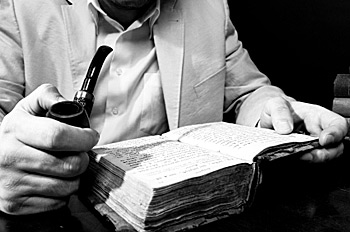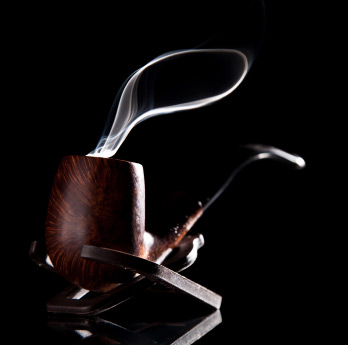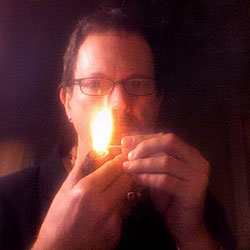The Care & Feeding of the Pipeman – by G. L. Pease
 Indulge me. Take a moment to close your eyes and reflect on your earliest experience as a budding pipe smoker. It could have been months ago, years, or even decades. Imagine that first bowl in as much vivid detail as you can conjure. How does the memory compare to your current experience?
Indulge me. Take a moment to close your eyes and reflect on your earliest experience as a budding pipe smoker. It could have been months ago, years, or even decades. Imagine that first bowl in as much vivid detail as you can conjure. How does the memory compare to your current experience?
Most of us, without much effort, can recall our first pipe, our first tobacco, our first smoke. For some, it was the opening of a sensory door that would lead to a wonderful new world of taste and aroma; for others, it was like entering a chamber of horrors, a dread-filled experience that, if lucidly recalled, makes us wonder why the hell we ever again chose to wander those darkly haunted halls.
 I’ll share mine. One of my high school science teachers smoked a pipe. I don’t remember much about his pipes, but I remember his tobacco well. He’d smoke in his office, in the lecture hall, when wandering the courtyard. The aroma of Borkum Riff often preceded his arrival, and mapped where he’d been; if you needed to find him, it was easy enough to follow the scent.
I’ll share mine. One of my high school science teachers smoked a pipe. I don’t remember much about his pipes, but I remember his tobacco well. He’d smoke in his office, in the lecture hall, when wandering the courtyard. The aroma of Borkum Riff often preceded his arrival, and mapped where he’d been; if you needed to find him, it was easy enough to follow the scent.
Mr. Havel, not any family member (the only relative I knew who smoked a pipe was an uncle by marriage, a cantankerous geezer whom I would sooner have avoided completely than chosen to emulate in any way), established my mental association between the pipe and men of science and learning. My journey into pipedom was thus set.
I confidently strode into the local druggist’s, a lanky, nerdy kid with my courage screwed as tight as a fully wound clock, to purchase my first pipe, an inexpensive Medico, sandblasted, blister-packed, hanging from a hook in the tobacco aisle. With it, of course, a pouch of Borkum Riff Whiskey, selected from the dazzling array of brightly hued pouches of Green Apple, Captain Black, Mixture 79, Sail, and all the other mass-market tobaccos that were once prominent in every supermarket and pharmacy. Despite being under-age, I managed to make my purchase without the gens d’armes being summoned, and left the shop armed with the necessary equipment, if not the knowledge, to become a pipeman. That afternoon, I attempted to emulate what I’d seen so many times, filling the bowl with the moist, fragrant leaf, pressing down with my thumb, testing the draw, for what, I had no clue, striking a match, and puffing enthusiastically, an impressively impenetrable fog enveloping my head and blinding me to the eye-rolling of my comrades. Any potential reverie was cut short when I was struck by violent spasms of coughing, interspersed with gasps for air and my friends’ raucous laughter. Lesson one: Do not inhale.
After recovering, I managed to get the thing lit again, and more amazingly, keep it going for a few minutes at a time, but by the time I’d burned through half the bowl, and most of a box of matches, I was dizzy, my tongue feeling as though a battalion of tiny soldiers in muddy boots and armed with flame throwers had marched across it, my mind filled with the sense that I had done something irreconcilably stupid. Then, waves of nausea crashed over me like the results of an E-ticket ride on the Whirl-n-Hurl. Lesson two: Do not puff continuously, no matter how cool it night look in the movies.
Why would anyone voluntarily visit this sort of torture upon themselves and claim to enjoy it? I was obviously missing something, doing something wrong. I tried again in a few days, with slightly less dramatic results, and then again and again. I tried a few other tobaccos, hoping that one of them might taste as "good" as they smelled. They didn’t. I managed to figure out how to keep the fires going a little longer, but still found little actual pleasure from the experience. Finally, I put the pipe and the tobacco away as a trophy of another failed experiment, and didn’t think about it again until I was at university.
A little knowledge, and some guidance on the care and feeding of the pipe might have gone a long way towards making those first trials less painful, and I suspect a lot of nascent pipe smokers fall off the rails because of similar experiences, tossing the offending pipe and pouch into a box in the attic to be covered with the dust of time, forgotten until the grandchildren go up to play.
Rattling about in my freshly matriculated mind, though, I still associated the pipe with the world of learning, and wanted to be a pipe smoker. All around me, professors and older students were seen with their pipes, as often used as devices for pointing out important details as they were instruments of smoking. Pipes were like little wooden hands in learning’s gloves. The pipe continued to call to me.
One misty fall day, I drifted into Drucquer & Sons, Berkeley’s premier tobacconists’, and put myself at the mercy of a patient fellow named Ken, who promised guidance. Over the months to come, I spent many of my free hours there, learning all I could, trying the different house-blends and the contents of exotic, beautifully decorated tins, acquiring over time a few inexpensive but good smoking pipes, always looking to the knowledgeable staff for guidance. Drucquer’s was like a pipe smoker’s reform school for me, and I owe whatever success I have had as a pipeman to the gentlemen there who gave freely of their time, and taught me the ropes. It was a much better beginning than my first aborted attempt; this time, it stuck.
We all have different stories, different reasons for being drawn towards the pipe, the most common and compelling being the pipe’s enticing aromas and it’s allusion to deeper thought, gentility, sophistication. And, for whatever reason, even those of us who suffered most from our ignorance of the pipe’s elusive ways persisted, eventually transcending the torture, and learning how to do it more or less right, ultimately becoming initiates into the sacred order of pipemen.
![]()
 Smoking a pipe is deceptively complex. It looks so easy when seen in black and white in some old film, a tweedy gent stuffing his pipe into a pouch, withdrawing it perfectly packed, and then lighting it with a single match, puffing between thoughts, surrounding himself with clouds of contentment, and on the surface, it really is pretty simple. Fill the pipe properly, apply flame, puff slowly, considerately, with a deliberate cadence that keeps the tobacco just smoldering, tamping as needed to tend the ember, relighting as required, keeping the pipe clean. It’s something that we’re told comes with time, with practice, and it usually does. We reach a level of competence fairly quickly, and our ability to discern different tastes from our tobaccos develops almost automatically as our brains assimilate and associate novel flavors with known ones. But competence is really only the beginning, and there’s much going on that seems to defy understanding that even when we feel we may have cultivated mastery of the skills, we can still get more out of the experience.
Smoking a pipe is deceptively complex. It looks so easy when seen in black and white in some old film, a tweedy gent stuffing his pipe into a pouch, withdrawing it perfectly packed, and then lighting it with a single match, puffing between thoughts, surrounding himself with clouds of contentment, and on the surface, it really is pretty simple. Fill the pipe properly, apply flame, puff slowly, considerately, with a deliberate cadence that keeps the tobacco just smoldering, tamping as needed to tend the ember, relighting as required, keeping the pipe clean. It’s something that we’re told comes with time, with practice, and it usually does. We reach a level of competence fairly quickly, and our ability to discern different tastes from our tobaccos develops almost automatically as our brains assimilate and associate novel flavors with known ones. But competence is really only the beginning, and there’s much going on that seems to defy understanding that even when we feel we may have cultivated mastery of the skills, we can still get more out of the experience.
For the majority of established pipe smokers, enjoyment seems to come without much effort. They’ll fairly quickly figure out what tobacco style or styles they like most, acquire a few pipes they enjoy, and happily puff away without a care in the world. If they, for some reason, have a bad smoke, they quietly accept it, confident that the next bowl will be better. They seem to have an innate sense of the pleasures and satisfaction of the pipe. I’m sometimes more than a little envious of these natural smokers.
For me, and I’m betting more than a few others, the quest for something more, for the mythical perfect smoke is a longer one. We have them once in a while, and bend our brains to figure out the steps necessary to recreate them. We explore different pipes, different tobaccos, different packing techniques. We geek out about airway diameters and bowl chamber geometries. We talk about what pipes get along best with different mixtures. We dry our tobaccos, or humidify them according to our latest thoughts on what the perfect moisture content should be. We experiment with different ways of preparing flakes, and argue over the best way to cut plugs. We talk about the way our mixtures taste using the vocabulary of other gustatory pleasures, of food, of wine. We discuss the best beverages to pair with different tobaccos, or the most harmonious season or time of day for particular blends. The forums are filled with lengthy discussions on these subjects, and more. Sometimes, it seems like we’re involved both in actual pipe smoking and in some strange sort of meta-layer surrounding the act itself. It’s part of the fun. When the stars align, my envy of the more confident approach taken by the natural smoker dissolves in wisps of bliss, and I wouldn’t have it any other way. Vive la difference.
![]()
The stream that comes from the pipe’s mouthpiece is a complex mixture of water vapor, dissolved sugars, smoke particles, and volatile organic components. What we experience as flavor is actually a composite impression of a complex interaction between taste and smell. As we puff, and the smoke swirls and cools on our tongue, we first notice the basic tastes of sweet, sour, bitter, salty and a sense of weight and warmth. Then, as we "chew" the smoke, some of the volatile components are delivered through the retro-nasal passages at the back of the throat into the olfactory nerves, adding a much richer dimension of perception. In fact, without this interplay of taste and smell we wouldn’t be able to differentiate complex flavors, and would be left with only the basic taste sensations. The so-called "Breath Smoking" technique, the act of puffing without puffing, of breathing normally and allowing delicate sips of smoke to find their way into our sensory apparatus, works as well as it does not just because we’re slowing down, burning less, warming and volatilizing more, but also because of the mechanisms of this retro-nasal olfaction. By breathing through the nose with a small amount of smoke in our mouths, the aroma components are accentuated, and we get a fuller experience of the tobacco’s character. It’s one of those cases where less is more.
Some smokers often blow smoke through their noses, or perform the impressive "French Inhale" maneuver. While fun, if overdone it can actually decrease what we taste. The olfactory bulb, the sense organ responsible for smelling things, quickly becomes overloaded when subjected to strong scents for an extended period, reducing the "taste" experience. This accommodation of the senses is one of the reasons we don’t smell our own tobacco as well as we smell someone else’s, and why our own smoke always smells more intense when we’ve stepped out of the room for a breath of air, and then return to the delectable clouds. (It’s often reported that habitual cigarette smokers "lose" their sense of "taste." It’s not so much lost, but misplaced. If they quit, even for a day or two, it usually comes back, and they’re often surprised by how much they’ve been missing.)
To the newcomer to the briar, and to those of us who periodically lose our way through complacency, and I include myself in that latter group, following are some ideas, most of which we all know but occasionally forget, that might help put us on the tracks to deeper enjoyment.
![]()
 The first thing to remember is simply to slow down and focus your attention; first impressions set the stage. Observe the tobacco, it’s color, it’s texture, its aromas. Consider your expectations of how that tobacco will taste. The meat and two veg of flavor perception happens in the brain, so give it a head-start instead of demanding it to catch up.
The first thing to remember is simply to slow down and focus your attention; first impressions set the stage. Observe the tobacco, it’s color, it’s texture, its aromas. Consider your expectations of how that tobacco will taste. The meat and two veg of flavor perception happens in the brain, so give it a head-start instead of demanding it to catch up.
Fill the pipe deliberately, and take a few "cold puffs" to sample the unburned purity of the taste and aromas. Then, light carefully, teasing the flame over the surface and puffing gently (not like in the movies). I’ve found that letting the pipe go out after the initial "charring light", allowing a few minutes before re-lighting, can amplify the tobacco’s flavor. As you puff, notice the feel of the smoke on your tongue. Is it heavy and chewy, or light and airy, oily and lingering, or delicate and ephemeral? Explore the tastes of the tobacco, and try to associate them with other familiar things. When we read reviews filled with colorful adjectives and descriptions of leather, campfire, grass or hay, green pepper, fruitiness, spiciness, do we experience what the reviewer describes, or something completely different? What about the after-taste, known to wine-tasters as the "finish?"
If you really want to expand your sensory vocabulary, take notes, especially when you’re having one of those particularly great smokes. This can be as elaborate as a smoking journal, with the date, time, weather, mood, music, beverage, pipe and tobacco notes, and everything you notice during the smoke, or as simple as a few notes of basic impressions scratched out the back of an envelope. What kind of spices? Fruits? Is there a savory quality, or is it more sweet? Be specific. This can be a lot of fun, and over time, will help with identifying not only individual perceptions, but the role that different tobaccos play in the flavor profile of a mixture’s composite smoke.
Smoke slowly, and when the pipe is going out, as pipes will often do, resist the urge to try to stoke the fires by aggressive puffing in an attempt to revive the dying ember. This rarely works, and often leads only to hot spots and a scorched tongue. Let it go, tamp very gently, and re-light.
Don’t overuse the tamper; I’m still guilty of this more often than I’d like to admit. The only time tamping is necessary is when it’s time to re-light, and the weight of the tamper is all that’s needed to settle the ash and give a nice surface for the flame to tease. Too much pressure will make the tobacco increasingly difficult to keep lit, and is probably the number two cause of Ye Olde Soggy Dottle (the number one being packing too tightly in the first place). If the tobacco in the bottom of the bowl ends up more like a dense cake of asbestos than fluffy goodness, you’ve over packed or over tamped. Dump it out, clean the pipe, and give it a rest. (Here is where the development of a good bottom cake reveals its value; it will help to retain the heat, absorb some of the moisture, and will make it easier to enjoy the last shreds of our precious leaf.) Keep your pipes clean. Nothing sours a smoke or makes it harsh more dramatically than a dirty shank. I like to leave a pipe-cleaner in the pipe until it cools, then doing a more thorough cleaning. Pipe cleaners are cheap insurance against premature souring of the pipe. For a while, I was neglecting this aspect of my smoking ritual, and ended up with a lot of foul tasting briars. After going through a box full of pipe cleaners and most of a bottle of Everclear, some of it used for cleaning the pipes, I learned my lesson.
As we evolve as pipe smokers, our tastes may change. The same tobaccos that gave us great pleasure might begin to suffer from the contempt bred by familiarity. It’s natural to want to explore new styles, and that’s a good thing. If you find yourself stagnating from a steady diet of the same meal, try something new. Novelty often opens new doors, so go out and explore.
Finally, take breaks. Just like our pipes, our palates need a rest once in a while. I often take a day or two away from the pipe, especially if I’m assessing new blends, in order to get the fullest possible experience of the flavors and aromas. This is especially important after a case of the dreaded "tongue bite." Often, this sort of reboot does wonders for bringing things back in line, breathing new life into even our most familiar weeds.
If the techniques outlined in this article bring a little more enjoyment to even one pipeman, my time in writing it will have been well spent. I’ll leave you with a little homework experiment. Fill a pipe with a favorite blend, air-dried to brittleness. Draw through the pipe to "cold taste" the tobacco. Pull big puffs into your mouth, and "chew" on them. With your mouth full of the tobacco’s aromatic goodness, keep it closed, and breathe through your nose gently. Now, from the bowl side, blow gently through the tobacco a few times to warm and moisten it. Repeat. Then, let the tobacco return to ambient temperature, and do it again. Record your experiences in your newly acquired smoking journal, and report in the comments section.
Your turn.
-glp
 Since 1999, Gregory L. Pease has been the principal alchemist behind the blends of G.L. Pease Artisanal Tobaccos. He’s been a passionate pipeman since his university days, having cut his pipe teeth at the now extinct Drucquer & Sons Tobacconist in Berkeley, California. Greg is also author of The Briar & Leaf Chronicles, a photographer, recovering computer scientist, sometimes chef, and creator of The Epicure’s Asylum. See our interview with G. L. Pease here. |

















Wow, what a wonderful article. Just super informative to the beginner and a great reminder to the experienced piper.
Great essay,Greg. I, too, started with Borkum Riff Whiskey, and had all sorts of technique problems. I really don’t remember how I solved the latter; my move away from the former stated when I discovered Sail Yellow, Troost, and other blends of that sort. I tend to over tamp, too, but am working on that.
It is always nice to read you Mr. Pease.
Thanks for the tips!
This is one of my favorite articles describing the journey of a pipe smoker, along with some great tips and reminders on how to best enjoy a pipe and tobacco.
Great article! I always enjoy reading your insights. My first pipe experience mirrored your in many ways. One never forgets his first, heh heh. You should publish a guide to pipe smoking. Wish I had been able to get one in the early days, but they tend to place books far away from tobaccos at the drug store.
This was really great reading as I just opened my delivery of a new pipe. I will put it aside and wait until later tonight when I can truly enjoy it.
Thanks for the enlightening yet easy reading.
great!
Thanks for the kind words, gentlemen, and glad you enjoyed mine. -glp
Greg – Great article as usual. Full of insightful insights. Interestingly, for me, I’ve found some of my most transcendent smokes have been those I’ve paid the least attention to. Especially those done whilst engrossed in a favorite book. I tend to stick with only three or four tobaccos (Westminster, Star of the East, Pirate Kake come to mind) that over the years I’ve come to deeply appreciate. Simplifying the menu so to speak sometimes allows one to go more fully into the nuances of the blend.
I wish I had read this article before my first attempt at smoking a pipe.
Great article, Greg. Useful advice for both the beginner and the experienced pipe smoker. After 30 years of the pipe, I’m still learning and a good deal of that comes from your writings. Thank you!
That was a great article! I used to smoke a pipe the same way I eat. If the food was really tasty, I ate more quickly. This doesn’t work with food and definitely doesn’t work with a pipe. Savor your food (and drink) and your pipe slowly. In smoking this saves your tongue. In eating this saves your waistline. Lessons learned from pipe smoking apply to many areas of life.
Great article! I’m still learning and I appreciate your wisdom.
Thanks for a great article Greg,you sure jogged my memory. I was maybe 12 or 13 when I borrowed one of my dad’s pipes and went down to the corner drug store and bought a pouch of Borkum Riff Whiskey(back then no one cared about kids buying tobacco). My buddy and I proceeded to attempt smoking said tobacco and like yourself did nothing but burn our mouths into oblivion. My dad and grandfather made it look so easy and so inviting, but it would be 3 decades before I picked up the pipe full time. Today I would consider myself a pipe geek as I do enjoy spending a lot of my free time talking pipes and tobacco and immersing myself into different aspects of this thing of ours.
Top notch!
Well said, as always, Greg. My first exposure to a “pipe man” came onlyy a few years ago on vacation. A silver haired gentleman, a few balconies over at our hotel would enjoy a 15 min smoke every afternoon. He made it look effortless, which I later learned too a wee bit of practice and patience. We never met, but he was my inspiration to start smoking a pipe.
great article,brought back lots of memories
As a crossover from cigars guy, and a pipe noob, this article is great. Well written…read it twice. Kudos.
*cheers*
Mike
Welcome to the pipe, and the wonderful world of pipe snobbery, Mike. Glad you joined up. More than a few of us enjoy a good cigar, as well.
.
-glp
Search as I might, I don’t have that first, clear memory of picking up the pipe. Best educated guess is that it was a cob and, most likely Cherry Blend or Borkum Riff.
Great article. Enjoyable and informative, thank you.
A great article, quite poetic on its style! And, if I may say, enticingly good enough to make me want to get my pipe out right now. Wonderful stuff. I remember my first pipe at the tender age of eighteen or so. A cheap pipe and over-the-counter pack of tobacco which I cannot remember. However unsuccessful I was with it, and I am pretty sure I was, the idea of being a pipe smoker stuck and in my mid thirties I took the hobby up properly, never looking back. Now, in my late fifties, I am only just beginning afresh to look at how I smoke and trying to improve my method and enjoyment. Instead of smoking a pipe as a cigarette alternative, I have bought a few new pipes this year (throwing out several of the old ones-really, they were no good for anything by this stage) with some great designs and looks, and I have tried variations in tobaccos too, striving for pure enjoyment through learning the different qualities of blends and even pipe design. I am beginning to taste for the the first time after all these years, as I allow the pipe and smoke to combine into their true pleasures. Reading articles like the above greatly help and nurture this wonderful pastime, and I can only hope that the powers that be allow us to enjoy it for a while to come. My thanks for a marvellous read and a great confirmation of this equally great hobby.
G.
geo3rge, I cannot tell you how much your comment means to me this morning. Thanks for making my day.
-glp